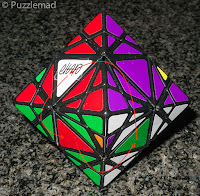This one was
Allard's
fault! He organised an MPP and I saw the puzzle there and after a very quick
fiddle decided I HAD to have one. Mrs S is gunning for Allard for causing yet
another toy to arrive in Sheffield. As I wrote
last week, I had seen this one receive a prize in the 2021
IPP design competition and forgotten about it until that MPP and then chatting with
Tom Lensch (who had made it) and ended up buying several wooden delights.
It is quite a chunky puzzle compared to Katsumoto-san's previous delights - these include the amazing Penta in a box and Slide packing puzzles which I reviewed
here back in 2016 or the 5L Box reviewed
here in 2020. Tom's lovely sturdy construction has a box with dimensions 10.4x7.4x7.0cm with the 4 Pacmen all being 6cm diameter and 3cm thick. The aim, clearly is to insert all 4 of the Pacmen into the box through a hole that is just the size to allow a single one through at a time. There are a bunch of hokes in the top, bottom and sides to allow finger poking and manipulation of the pieces. It looks pretty simple really - I could not immediately see what all the fuss had been about but knew that to achieve the accolade and reviews that it had, there must be something special to it.
Having established early that this was not as simple as it looked, I moved onto the other arrivals so as to have something for the blog. I was relatively horrified when other puzzlers mentioned that they were significantly struggling with it. I finally got a chance to play properly and started (as I am sure that everyone does) looking for ways that the Pacmen could interlink to allow them to fill a 2x2x3 unit space before trying to find ways to get them in to said space through a small hole. It transpires that there are a few very nice pretty ways to arrange the pieces and they all looked problematic. I did wonder whether there would be enough space to make them spin on each other once inside the box and quickly found out that nope! this was not a possibility without cracking the acrylic lid.
This finding ruled out my first attempt at a solution but I had a couple of others up my sleeve and tried those one after another. This was fun until I realised that none of those solutions were achievable either. At one point, during an exhaustive search for a way to flip a pair of Pacmen, I did something that looked fabulous and then went nowhere. I then spent a good 30-45 minutes desperately trying to undo the move I had done - it was really quite tight and needed the piece arrangement just perfect to be possible. This frightened the crap out of me again and I determined not to try that again.
I was stuck - just as Allard had been stuck for a while. It is very straightforward to put 3 inside but after that there seems to be no movement possible. The placement of the last one is very obvious as soon as you begin to think© about it but leaving that space with the others seemed to be impossible. I spent another week in this position trying inside and outside the box.
I was so stuck that I took out another puzzle that has frightened me to death for a few months - Eitan's edge turning octahedron looks a fearsome puzzle and I had been too fearful to even investigate it but I needed to think about something else for a while and decided to try a few algorithms to clear my mind.
Having tried a few things on that like the edge piece series, a variant of the corner piece series and looked for a way to make a commutator. I decided it was time to go back to 4 PAC. As always, it just looked so simple. The pieces are cylinders with 90º wedges cut out, the box is a 2x2x3 container - how hard can it be? I kept fiddling and even braved my previous awkward move and worked out how to go back and forth with it.
I was sitting with Mrs S one evening watching TV and idly placing pieces inside whilst trying various moves but not really trying very hard or even paying a lot of attention - I think that Wednesday Adams was distracting me when I suddenly looked down and realised that I had a new arrangement of the pieces and if I just rotated the last one then I would have it solved. Mrs S was not terribly impressed when I showed her (she thought it looked remarkably easy!)
Like Allard, I had almost solved it my accident. I had them inside the box arranged in a way that had not occurred to me to try when looking outside the box. The sequence of moves is particularly clever and the solution really totally unexpected. The sense of achievement (even if I solved it accidentally) was fabulous. In reality, I would say that you cannot solve it randomly, you do need to try certain distinct moves but the final assembly will hit you with a surprise.
If you get a chance to play with a copy then it is very well worth your while. Thank you Hajime and Tom for a fabulous fun challenge.





















